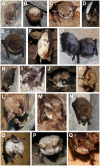Pan-European distribution of white-nose syndrome fungus (Geomyces destructans) not associated with mass mortality
- PMID: 21556356
- PMCID: PMC3083413
- DOI: 10.1371/journal.pone.0019167
Pan-European distribution of white-nose syndrome fungus (Geomyces destructans) not associated with mass mortality
Abstract
Background: The dramatic mass mortalities amongst hibernating bats in Northeastern America caused by "white nose-syndrome" (WNS) continue to threaten populations of different bat species. The cold-loving fungus, Geomyces destructans, is the most likely causative agent leading to extensive destruction of the skin, particularly the wing membranes. Recent investigations in Europe confirmed the presence of the fungus G. destructans without associated mass mortality in hibernating bats in six countries but its distribution remains poorly known.
Methodology/principal findings: We collected data on the presence of bats with white fungal growth in 12 countries in Europe between 2003 and 2010 and conducted morphological and genetic analysis to confirm the identity of the fungus as Geomyces destructans. Our results demonstrate the presence of the fungus in eight countries spanning over 2000 km from West to East and provide compelling photographic evidence for its presence in another four countries including Romania, and Turkey. Furthermore, matching prevalence data of a hibernaculum monitored over two consecutive years with data from across Europe show that the temporal occurrence of the fungus, which first becomes visible around February, peaks in March but can still be seen in some torpid bats in May or June, is strikingly similar throughout Europe. Finally, we isolated and cultured G. destructans from a cave wall adjacent to a bat with fungal growth.
Conclusions/significance: G. destructans is widely found over large areas of the European continent without associated mass mortalities in bats, suggesting that the fungus is native to Europe. The characterisation of the temporal variation in G. destructans growth on bats provides reference data for studying the spatio-temporal dynamic of the fungus. Finally, the presence of G. destructans spores on cave walls suggests that hibernacula could act as passive vectors and/or reservoirs for G. destructans and therefore, might play an important role in the transmission process.
Conflict of interest statement
Figures




References
-
- Anonymous . Austin, Texas; 2009. White Nose Syndrome science strategy meeting II, Consensus Statement.
-
- Meteyer CU, Buckles EL, Blehert DS, Hicks AC, Green DE, et al. Histopathologic criteria to confirm white-nose syndrome in bats. J Vet Diagn Invest. 2009;21:411–414. - PubMed
-
- Reichard JD, Kunz TH. White-nose syndrome inflicts lasting injuries to the wings of little brown myotis (Myotis lucifugus). Acta Chiropt. 2009;11:457–464.
-
- Gargas A, Trest MT, Christiensen M, Volk TJ, Blehert DS. Geomyces destructans sp. nov. associated with bat white-nose syndrome. Mycotaxon. 2009;108:147–154.
-
- Rice AV, Currah RS. Two new species of Pseudogymnoascus with Geomyces anamorphs and their phylogenetic relationship with Gymnostellatospora. Mycologia. 2006;98:307–318. - PubMed
Publication types
MeSH terms
LinkOut - more resources
Full Text Sources
Medical

